AMD EPYC 3201 Benchmarks
For this exercise, we are using our legacy Linux-Bench scripts which help us see cross-platform “least common denominator” results we have been using for years as well as several results from our updated Linux-Bench2 scripts. At this point, our benchmarking sessions take days to run and we are generating well over a thousand data points. We are also running workloads for software companies that want to see how their software works on the latest hardware. As a result, this is a small sample of the data we are collecting and can share publicly. Our position is always that we are happy to provide some free data but we also have services to let companies run their own workloads in our lab, such as with our DemoEval service. What we do provide is an extremely controlled environment where we know every step is exactly the same and each run is done in a real-world data center, not a test bench.
We are going to show off a few results, and highlight a number of interesting data points in this article.
Python Linux 4.4.2 Kernel Compile Benchmark
This is one of the most requested benchmarks for STH over the past few years. The task was simple, we have a standard configuration file, the Linux 4.4.2 kernel from kernel.org, and make the standard auto-generated configuration utilizing every thread in the system. We are expressing results in terms of compiles per hour to make the results easier to read:
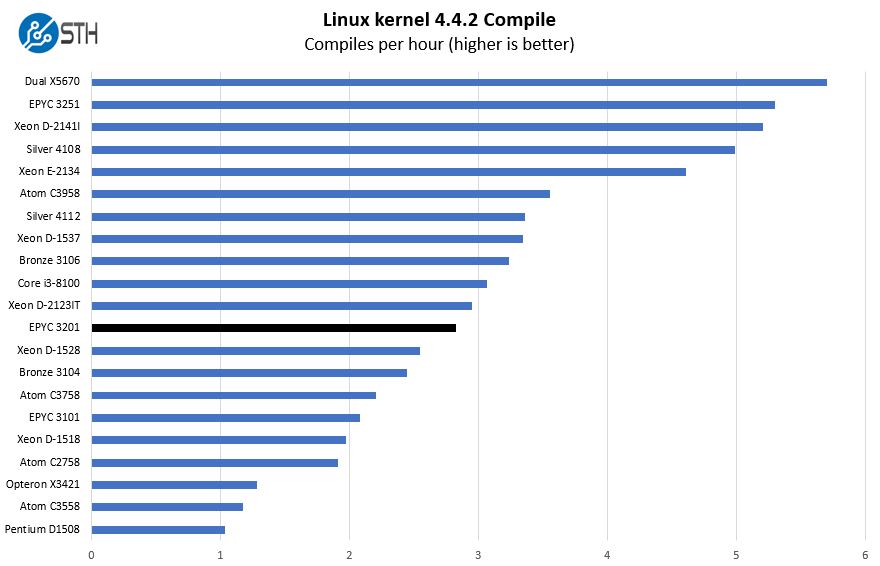
In this performance review, you are going to see why the AMD EPYC 3201 is something completely different than what we have seen from Intel. Here we have an AMD EPYC 3201 (30W TDP) that is faster than an Intel Xeon Bronze 3104 (85W TDP) and an Intel Xeon D-1528 (35W TDP.)
One of the other key themes here is that there is a big delta between the AMD EPYC 3201 and EPYC 3251. That extra TDP matters and AMD is making use of it.
c-ray 1.1 Performance
We have been using c-ray for our performance testing for years now. It is a ray tracing benchmark that is extremely popular to show differences in processors under multi-threaded workloads. We are going to use our 4K results which work well at this end of the performance spectrum.
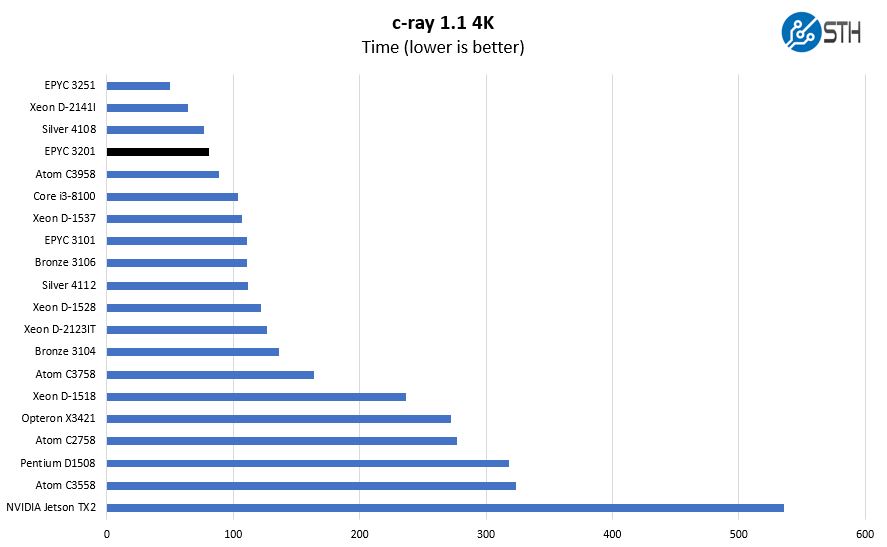
Here the AMD EPYC 3201 does well based on the Zen microarchitecture and having eight physical cores. AMD likes to use these types of benchmarks, of which Cinebench is similar, just because it does so well.
7-zip Compression Performance
7-zip is a widely used compression/ decompression program that works cross-platform. We started using the program during our early days with Windows testing. It is now part of Linux-Bench.

Here we can see the impact of SMT which is really interesting. Looking at the AMD EPYC 3251, the decompression bar is longer than the compression bar. On the AMD EPYC 3201 and AMD EPYC 3101 that do not have SMT, that relationship is flipped.
As an aside, this piece is also the world first AMD EPYC 3101 benchmarks. We are showing both the top end and bottom end of the single die AMD EPYC 3000 Snowy Owl SKUs here. John is almost done with his AMD EPYC 3101 review piece.
NAMD Performance
NAMD is a molecular modeling benchmark developed by the Theoretical and Computational Biophysics Group in the Beckman Institute for Advanced Science and Technology at the University of Illinois at Urbana-Champaign. More information on the benchmark can be found here. Here are the comparison results for the legacy data set:
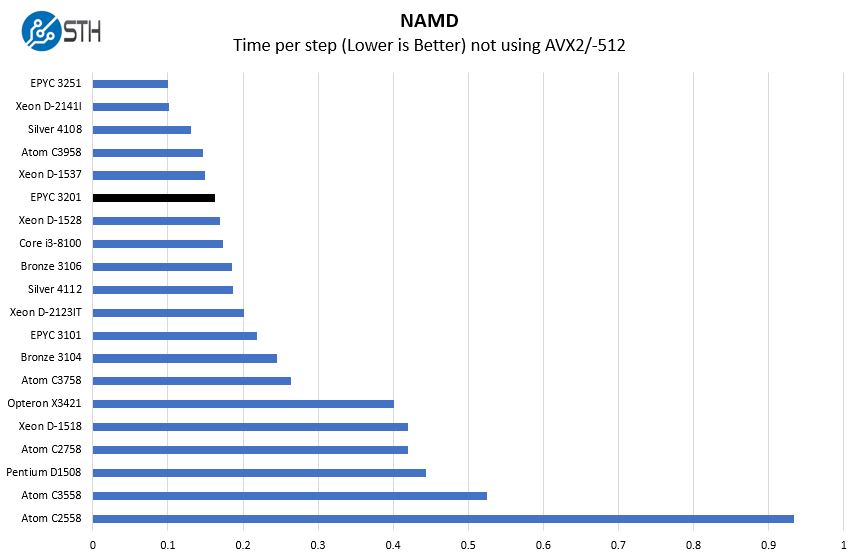
Again, the lack of SMT and lower clock speeds hurt the AMD EPYC 3201 here, but it still performs well.
Sysbench CPU test
Sysbench is another one of those widely used Linux benchmarks. We specifically are using the CPU test, not the OLTP test that we use for some storage testing.

Here one can see that the AMD EPYC 3201 is faster than the Intel Xeon Bronze 3106 and Silver 4112 CPUs. Those are mainstream Skylake SKUs with higher TDP and more IO, including needing a PCH. For this class of part, this is nothing short of impressive.
OpenSSL Performance
OpenSSL is widely used to secure communications between servers. This is an important protocol in many server stacks. We first look at our sign tests:

Here are the verify results:
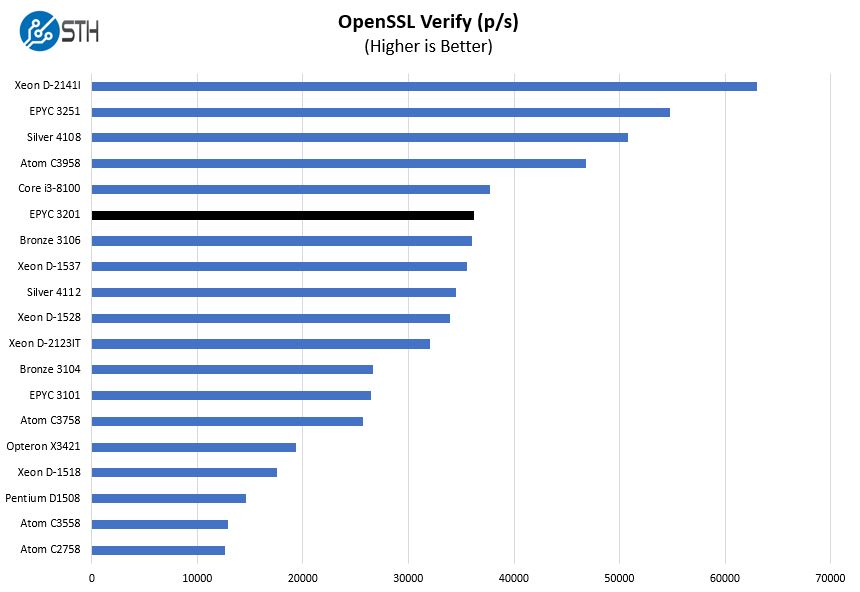
OpenSSL is widely used, and perhaps even more so in segments of the embedded space. Here the AMD EPYC 3201 is locked into a close race with the Intel Xeon D-1537 which is still considered a current product in the middle of its lifecycle.
UnixBench Dhrystone 2 and Whetstone Benchmarks
Some of the longest-running tests at STH are the venerable UnixBench 5.1.3 Dhrystone 2 and Whetstone results. They are certainly aging, however, we constantly get requests for them, and many angry notes when we leave them out. UnixBench is widely used so we are including it in this data set. Here are the Dhrystone 2 results:
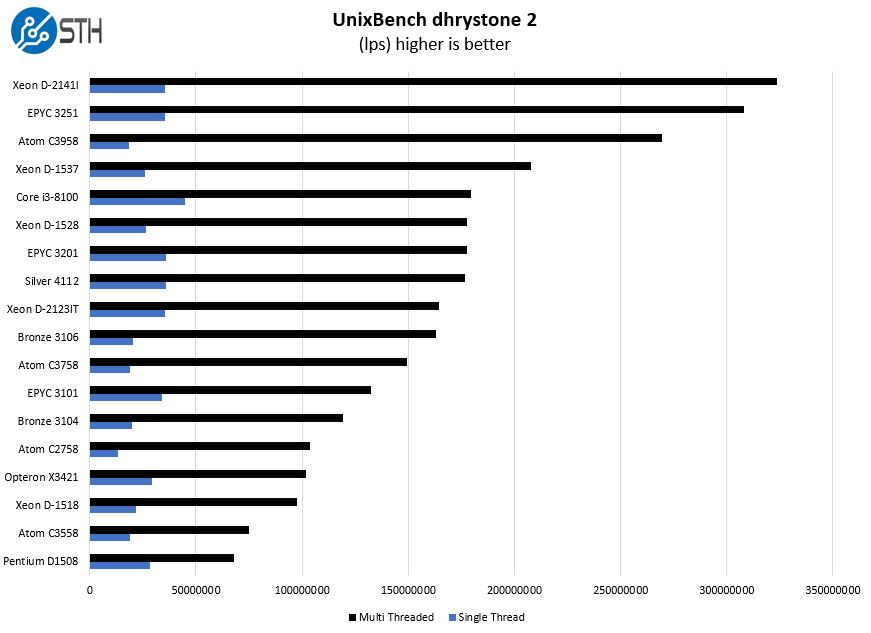
Here are the whetstone results:
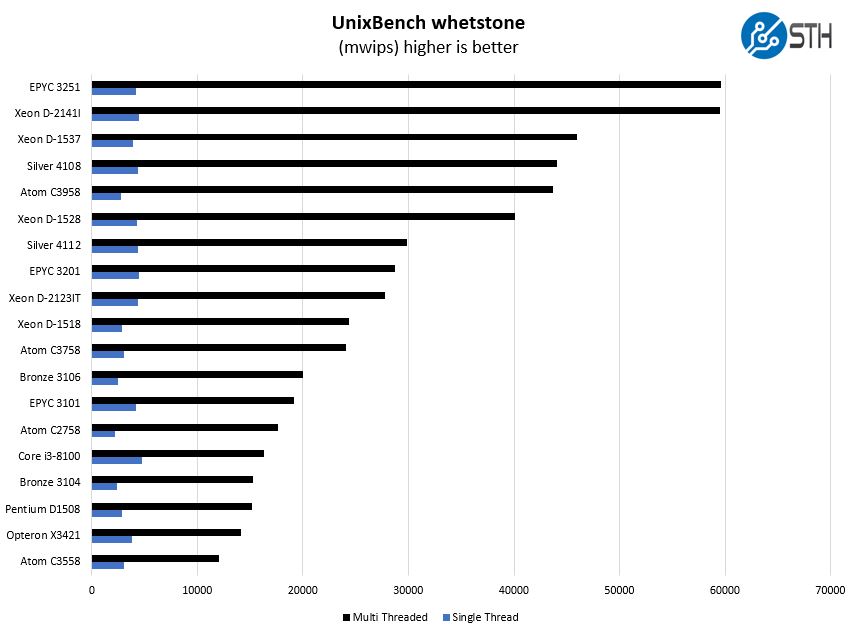
Here we wanted to point to the delta between the AMD EPYC 3251 and AMD EPYC 3201 and compare that to the AMD EPYC 3101 and the EPYC 3201. The AMD EPYC 3101 actually has a higher base clock speed and TDP than the EPYC 3201 so we are seeing a smaller delta there which is intriguing.
GROMACS STH Small AVX2/ AVX-512 Enabled
We have a small GROMACS molecule simulation we previewed in the first AMD EPYC 7601 Linux benchmarks piece. In Linux-Bench2 we are using a “small” test for single and dual socket capable machines. Our medium test is more appropriate for higher-end dual and quad socket machines. Our GROMACS test will use the AVX-512 and AVX2 extensions if available.
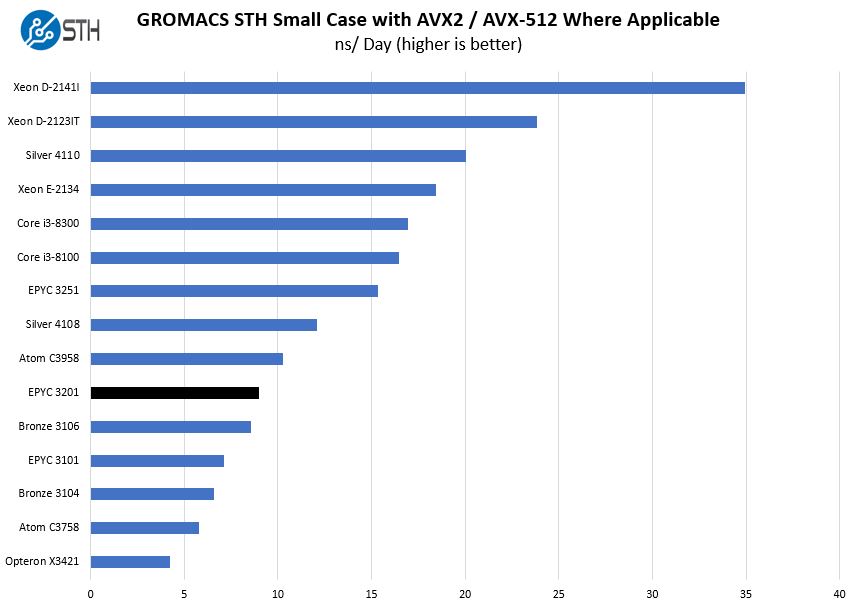
This is simply a case where the Intel Xeon D-2100 series family pulls away. Officially the Skylake-D is noted as having single port FMA AVX-512 like the Intel Xeon Bronze, Xeon Silver, and Xeon Gold 5100 series. Clearly, Intel has dual port FMA AVX-512 on the Intel Xeon D-2100 series. I have asked Intel, and nobody will confirm that they are de-featuring the spec sheet, but I have received a “that is a very wise question” when asking it to someone at Intel who should know.
Because of that, if you can use AVX-512 and need that performance, the AMD EPYC 3201 is not your best choice in the embedded market.
Chess Benchmarking
Chess is an interesting use case since it has almost unlimited complexity. Over the years, we have received a number of requests to bring back chess benchmarking. We have been profiling systems and are ready to start sharing results:
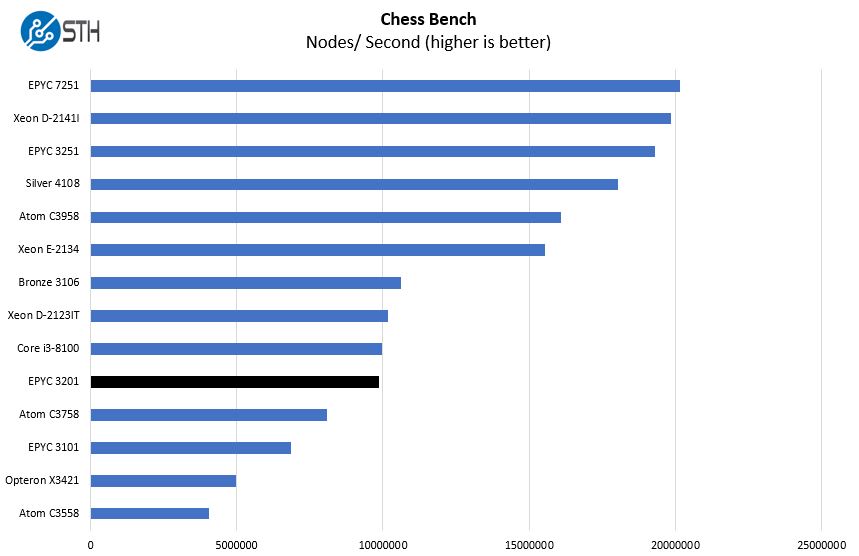
The Intel Xeon D-2123IT is a four core/ eight thread chip from Intel that comes with a 60W TDP. The AMD EPYC 3201 uses eight lower clocked cores without SMT to achieve a similar level of performance here using only eight cores/ threads and a 30W TDP. We will have our power consumption figures with the platform reviews, but from what we are seeing, the AMD EPYC 3201 uses significantly less power than the Xeon D-2123IT under load.
Next, we are going to talk AMD EPYC 3201 market positioning before moving on to our final words.

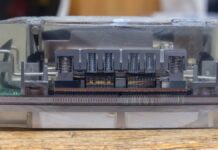


That’s a great point on the supplier diversity. We’ve exclusively used Intel for over 6 years but that AVR54 bug hurt and we didn’t have an answer. We’re going to buy whatever comes out first if it fits our use and see if we can qualify a different part. We’ve got a few customers that would prefer their HA pair to be similar performance but with different components so they don’t get caught stuck with that AVR54 worry
Xeon D-2100 pricing is f*ing crazy. Dilly Dilly to AMD getting in there and stopping runaway embedded pricing.
If AMD’s cheaper, I’m going to buy 1-3 just to show support and keep them going.
What I don’t understand about the current ecosystem is that nobody seems to be building embedded parts based on the 3000 series. While you can purchase several Xeon D boards with embedded CPU I haven’t seen anything indicate that Epyc parts are coming. Even SuperMicro officially announced that they have no parts in the planning.
So here’s to hope that AMD will produce boards with embedded CPUs themselves to get the market to follow.
Patrick, thanks for all the hard work – I don’t suppose you know the volume pricing on the 3201 do you?
I’d love to know if it comes out cheaper than the 3758? It feels like a direct competitor to me, considering it’s only 5w more and in /most/ benchmarks it’s anywhere from 5 to near 40% faster.
I can only hope for good things for this platform moving forward, hopefully lots of linux, windows, freebsd / freenas support.
Good to have some options.
I do not have volume pricing on this. Our EPYC 3000 launch piece has two SKUs, but not this one.
I am committed to producing a viability study for the practicality of immediate commencing manufacturing of the very similar products. (this said, I cannot say that the actual product designs are very much more exciting than what is seen in the market and its also fact that we are wanting to manufacture for customers with demand for unique product and services for their businesses, and unlike the public market in our area we have a lot of capacity to entertain high quality and finish quality products in retailers that would be very expensive sales for comparison. If you have any more interest then please contact me by all means the potential to be financed in a manner that will permit paid full equity in the additional compensation, very possible to who is relaxed to take the product from the errors which must be eliminated to last inspection, with the least personal concerns of stress and who is as concerned about why everything is slow in this market and no explanation is certain and sufficient. We want to be odm and to be retail for potential cases design as well as selling the limited edition stocks that are different completion of bigger customer service and specifications making.
Why Supermicro has crippled this great platform?
We could have:
8x SATA (RAID 0,1,5,10)
4x 10 GbE
2x M.2 Slots (like ASUS P11C-M/4L has)
1x 24-pin ATX power connector for PicoPSU
I can only hope another manufacturer will solder Epyc 3201 to a mATX board, so I can get rid of my power hungry 2011-3 RDIMM based homelab. ;-(
Simon – I think that page will get updated.
Stephan – with these, you simply need a DC power cable and do not need the PicoPSU. You can run them directly from a power brick. The appeal of this model is you can skip the extra power supply.
Patrick – Maybe I can somehow connect a 12V DC power brick to the mainboard itself (DC plug to 8-PIN EPS adapter – part number?) but how do I then power SSDs & HDDs? Retail package contains 4x SATA cable but CBL-PWEX-0982 offering only one SATA power connector and there is no information in manual about how much milliampere we can drain from J6 without smoke.
Recommended case E300 has a DC connector but the cable inside the case to 8-PIN mainboard connector is not in parts list.
Supermicro already made a mainboard I’m searching for: A2SDV-8C-TLN5F. I want this board with Epyc 3201 and 8x SATA.
It seems to be modern these days to sqeeze everything to the smallest possible formfactor at any costs.
Low power server CPU and ATX form factor for expansion cards and features? – exactly one mainboard available: Gigabyte MB51-PS0. This is so sad.